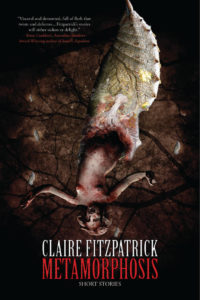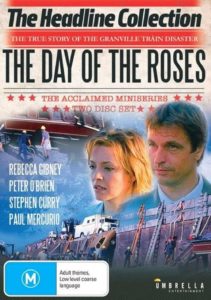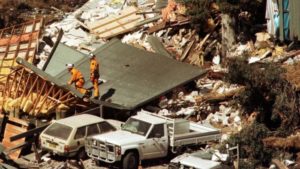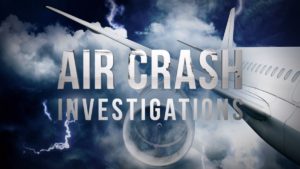One of the most common questions authors face is a deceptively difficult one to answer: “Where do you get your ideas?” Yet, the answers to that common question can be almost as interesting as the resulting story. Welcome to You’re My Inspiration, a new column dedicated to discovering what inspires a particular author and their work. Whether it be a lifelong love of mythical creatures, a fascinating bit of history, or a trip to a new and exciting place, You’re My Inspiration is all about those special and sometimes dark things that spark ideas and result in great stories.
For our very first installment, we bring you horror author from Down Under and body-horror specialist, Claire Fitzpatrick, whose debut short fiction collection, Metamorphosis, will be released on September 2nd from IFWG Publishing!

Gerry Huntman, Managing Director of IFWG, has described Claire as a “firm, niche voice in the horror field.” So what, exactly, shaped that voice? Well, inspiration can come from many different sources, and not all of it is beautiful. Let Claire explain…
Morbid Curiosity in Technicolour
I can’t recall any defining book or film that set me on my course of becoming a horror writer. I do, however, remember three very specific horrific events on TV that left a distinct impression on me as a child — that death was everywhere.
 I was quite young, around 7, when the two-part docudrama The Day of the Roses came on. I was living in New South Wales at the time. My parents were out, and my sister and I were in their bed, watching TV, as our 60ish-year-old babysitter was in the loungeroom doing whatever it was 60ish-year-old babysitters did. Probably drinking port, as she liked to do. My sister was asleep, and as I was flicking through the channels, I stopped at a grisly scene of a woman trapped underneath a derailed train. I don’t know why it caught my attention. Maybe it was the look of sheer horror on her face as she struggled to free herself? Maybe it was because she was surrounded by the fellow-injured and the dead? I have no idea.
I was quite young, around 7, when the two-part docudrama The Day of the Roses came on. I was living in New South Wales at the time. My parents were out, and my sister and I were in their bed, watching TV, as our 60ish-year-old babysitter was in the loungeroom doing whatever it was 60ish-year-old babysitters did. Probably drinking port, as she liked to do. My sister was asleep, and as I was flicking through the channels, I stopped at a grisly scene of a woman trapped underneath a derailed train. I don’t know why it caught my attention. Maybe it was the look of sheer horror on her face as she struggled to free herself? Maybe it was because she was surrounded by the fellow-injured and the dead? I have no idea.
As I grew older, I learned The Day of the Roses was about the 1977 Granville railway disaster. Today, it remains the worst rail disaster in Australian history and the largest loss of life in a confined area post war. At 8:10am on the 18th of January 1977, the 6:09am train from Mount Victoria in the Blue Mountains was headed towards the city when it derailed and rammed into the supports of the Bold Street bridge in Granville. The bridge collapsed, causing 470 tonnes of concrete and steel to fall onto two carriages of the train. 84 people died. More than 213 were injured. A total of 1,300 were affected.
I don’t know why the image of the disaster is imprinted in my mind. I wasn’t there. I wasn’t even alive then. I didn’t know anyone who’d been there. I think it seemed strange that a simple car bridge could do such damage. But perhaps it was because I learned of the accident when I was a child? Children are sponges, after all. Maybe it became a nightmare I was somehow part of? I can’t remember.
Not long after watching the docudrama, the 1997 Thredbo landslide occurred. I don’t recall if we were watching the news or not, but I remember learning about the incident, as I went to primary school in the Shoalhaven area of New South Wales, and the year 6 kids went to Thredbo for the end of primary school camp. Half an hour before midnight on Wednesday July 30, 1997, the earth gave way and the mud thundered down the steep slopes of the Thredbo ski resort, destroying two lodges. One was a four-storey ski club lodge with just one occupant, the other was a staff lodge with 18. All 19 were trapped under a mess of earth, debris, and heavy concrete slabs. A single man survived; a man trapped for 65 hours beside the body of his wife. It seemed so grotesque to me — trapped for so long besides someone who had died, trapped beside the body of the one you loved.

Image from ABC News
My family moved to Queensland in 2001 when I was around 11 or 12. I soon became enthralled by the idea of natural disasters and developed a fascination for finding out more information on disasters in my area. But not a lot happened near me, and life felt strangely dull. Until one morning awoke to my father in the loungeroom staring at the TV. He was a scaffolder and was usually gone before I got up for school. However, this morning he seemed transfixed to the television, staring at it in a mixture of bizarre fascination and disbelief. I stood beside him and watched as the World Trade Center’s Twin Towers collapsed, engulfed in a pillar of fire and smoke. As I watched the images of people fleeing the area, covered in blood, dragging the dead, a bizarre image came into my mind — a collage of trains, landslides, burning buildings, dead bodies, and people screaming. I’m not sure if my sister and I went to school that day. I don’t know anyone who did.
Over the years, more disasters followed. The 2003 Canberra bushfires. The 2006 Beaconsfield Mine collapse. The 2009 Black Saturday bushfires. It all seemed to come one after the other. Of course, disasters happen everywhere you go. It’s not uncommon to know someone who’s been affected by one. There’s a joke in the family that we shouldn’t exist because of that one time my Scottish great-grandmother missed that damn boat that sunk in 1912.
I’m now 28, and I still have a fascination with disaster shows and documentaries. In fact, one of my favorite shows is Air Crash Investigations. I’m also interested in the mechanics of trains and aeroplanes, and even wanted to be a pilot. I like learning about how things work, why things break, and how to fix things so they won’t break again. I like writing about taking things apart and putting them back together. I enjoy learning about anatomy, and the machinations of the human body. I developed a keen interest in anthropology, and the ways in which societies work together during horrific accidents or events. I’m currently pitching a Masters idea about the hedgehog’s dilemma, a metaphor used to explain introversion and self-imposed isolation. And it’s interesting, since that’s exactly the opposite of what happens during these events. Instead of isolating themselves, total strangers risk their lives to help one another. Yes, death is everywhere, but it doesn’t have to be.

Apparently, there’s a scientific reason why we can’t turn away from tragedy. Carl Jung suggested our mental health depends on our shadow, that part of our psyche that harbors our darkest energies, such as melancholia and murderousness. The more we repress the morbid, the more it foments neuroses or psychoses. To achieve a kind of unity, we must acknowledge our most demonic inclinations. I couldn’t stop watching people leap to their death from the Twin Towers. There’s something about tragedy that stops me in my place and demands my complete and total attention. However, it seems like once we welcome these grim events into our psyche, we’re able to comprehend them more, find the humanity in the darkness.
I don’t know if being aware of catastrophic events and natural disasters at a young age helped me to become the horror writer I am today, but it has certainly assisted with my natural curiosity of the macabre. I’ve held them in high regard as the moments that made me stop and think of all the true and natural horrors of the world. Through them, I’ve learned life is filled with unplanned events, unforeseen catastrophes, and a lot of fodder for creative writing. That’s not to say I look forward to disasters — I simply find them interesting and remain morbidly fascinated. It’s one of the few things that’s stuck with me as a kid. I’m sure life would have been much different if I’d remained interested in Green Teen Skipper dolls, but often the things that stick with you aren’t what you necessarily expect. Life is weird that way. I suppose that’s why writers are weird, too.
 Claire Fitzpatrick is an award-wining author of speculative fiction and non-fiction. She won the 2017 Rocky Wood Award for Non-Fiction and Criticism. Called “Australia’s Queen Of Body Horror” and “Australia’s Body Horror Specialist,” she enjoys writing about anatomy and the darker side of humanity. Visit her at www.clairefitzpatrick.net/.
Claire Fitzpatrick is an award-wining author of speculative fiction and non-fiction. She won the 2017 Rocky Wood Award for Non-Fiction and Criticism. Called “Australia’s Queen Of Body Horror” and “Australia’s Body Horror Specialist,” she enjoys writing about anatomy and the darker side of humanity. Visit her at www.clairefitzpatrick.net/.Want to talk about what inspired you as a writer, and/or your current release? Check out our guidelines and fill out the form here.

Claire, thank you for joining us, and thank you for the fascinating read!
Have you ever read The Unthinkable: Who Survives When Disaster Strikes – and Why by Amanda Ripley? It’s about the science of how people react during a crisis as explored through disasters like September 11th, the Virginia Tech shootings, and plane crashes. It’s not as grim and depressing as it sounds.
No, but it sounds like something I’d enjoy!
[…] Next, we have guest Claire Fitzpatrick joining us for our new column, You’re My Inspiration, which focuses on “those special and sometimes dark things that spark ideas and result in great stories.” This is bigger than the MFT – we’re talking about the life-changing, awe-inspiring, creative muses! So, what inspires Claire’s unique voice and brand of (body) horror? Take a look! […]